#Cat6Cables
Explore tagged Tumblr posts
Text
Making Cables
Cat6 RJ45
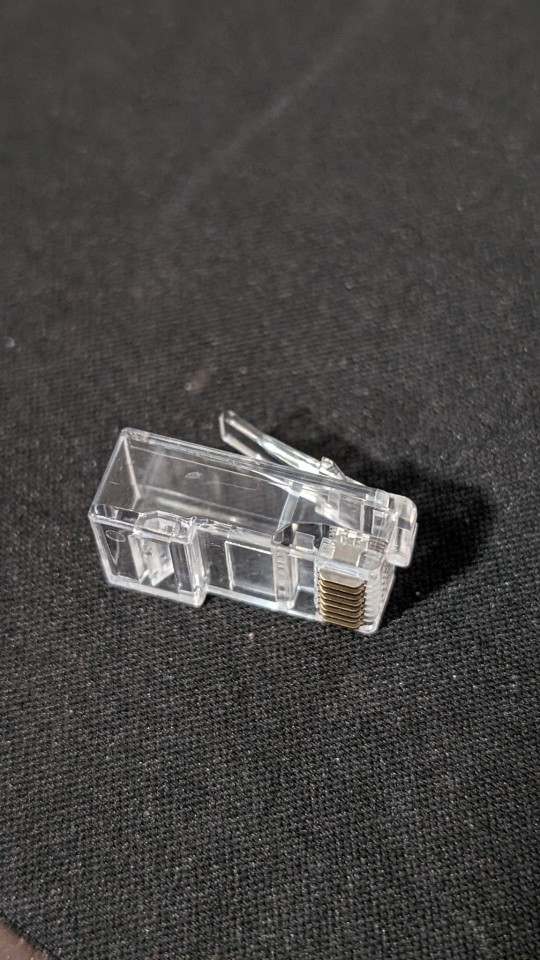

Cat5e RJ45 vs Cat6 RJ45
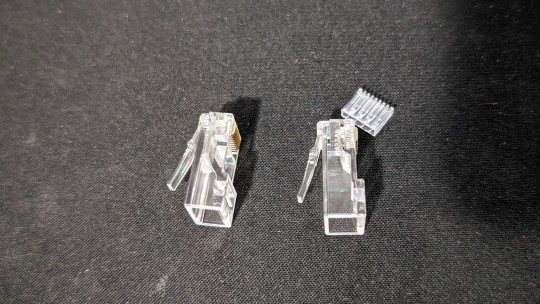
Cat5e RJ45

You might could use a cat5e RJ45 head with a cat6 cable, but it would certainly be a struggle. Definitely happy I finally picked up these cat6 heads.
2 notes
·
View notes
Text
9 Reasons Why Armoured Cable is the Superior Choice

Let’s be honest: the world of cables can be a knotted chaos. For internet speeds that will make a cheetah envious, you have your CAT6, CAT6A, your reliable HDMI for those epic movie nights, and a maze of other cables that power everything from your kitchen appliances to your gaming system (because, well, priorities). But there’s one cable that stands out from the pack, a knight in shining – well, maybe not shining, but definitely protected – the armoured cable.
Now, you might be thinking, “Armoured cable? Sounds fancy, but is it really all that necessary?” Well, buckle up, because we’re about to dissect this marvel of engineering and show you why it deserves a permanent place in your networking toolbox (or, more realistically, your network engineer’s).
Reason #1: Superior Physical Protection
Imagine your wires as the delicate diplomats of your project. They carry vital information (data/current) and need a safe passage. Standard cables, while functional, are vulnerable to physical trauma. A stray nail during construction or a nibbling rodent in the attic – these seemingly insignificant threats can spell disaster for your networking system.
Armoured cable, however, is a fortress. Its secret weapon? A robust metallic armour, typically made of interlocking steel or aluminium tape. This impenetrable layer acts as a shield, deflecting blows from sharp objects, resisting crushing forces, and deterring those pesky critters who consider standard wires as a midnight snack.
Reason #2: Excellent EMI/RFI Shielding
Networking is a complex blend of electromagnetic interference (EMI) and radio frequency interference (RFI) that surround us. These invisible things can create chaos in your signals, causing everything from data corruption to erratic equipment behaviour. But fret not, for armoured cable has another trick up its metallic sleeve.
The same armour that provides physical protection also acts as a Faraday cage. By creating a barrier around the inner conductors, armoured cable significantly reduces the impact of EMI/RFI. This is an even more high-priority thing for sensitive devices in data centres, hospitals, and industrial setups where preserving pristine signals is critical.
Reason #3: Bending the Rules (Without Breaking Them) – Superior Flexibility
For instance, you are in a scenario where you demand a bit of flexibility – running wires around corners, navigating tight spaces. Standard conduit systems can be rigid and cumbersome here. Armoured cable, on the other hand, strikes a beautiful balance between flexibility and protection.
Though it shows off a hard covering, the inner conductors and insulations are as a rule developed with flexibility in mind. This permits less complicated manoeuvring in the course of installation, saving you time and irritation, particularly in those awkward nooks and crannies.
Reason #4: Top-notch Environmental Resistance
The networking world doesn’t exist in a vacuum. It’s possible that your cables will have to withstand the harsh desert sun, the unceasing rain, or the chilly temperatures of winter. Standard cables, while functional indoors, can succumb to the harsh realities of Mother Nature.
Armoured cable, however, is built to endure. The outer jacket materials are often chosen for their resilience to harsh weather conditions. This can include UV-resistant polymers for sun protection, water-tight seals for wet environments, and even flame-retardant properties for added safety.
Reason #5: Diverse Applications

Armoured cable has more than one function. Because of its adaptability, it is a preferred option for many different kinds of applications. Here are a handful of instances:
Industrial Settings: Powering heavy machinery, control panels, and lighting systems in factories and workshops.
Construction Sites: Supplying temporary power for construction tools and equipment.
Underground Installations: Providing a robust and weatherproof solution for buried electrical lines.
Signage and Lighting: Supplying power to outdoor signs, landscape lighting, and other outdoor electrical/networking fixtures.
Reason #6: Installation Efficiency – Saving Time and Money
Time is money, especially in the world of networking projects. Armoured cable streamlines the installation process by combining multiple functionalities into one neat package.
Here’s how:
Eliminates the Need for Conduit: Forget the hassle of installing separate conduit systems. Armoured cable provides its own built-in physical protection, saving you time and labour costs.
Reduces Connections: The integrated grounding conductor cuts out the requirement for a separate grounding cable, facilitating installation and minimizing the number of potential connection points that could end up being problematic later.
Flexible Handling: As discussed earlier, these cables provide a degree of flexibility, enabling simpler navigation around obstacles and through tight spaces. This translates to speedier installation instances compared to rigid conduit systems.
Reason #7: A Long and Healthy Life – Superior Durability
So, you want your wires to last the long haul? Standard cables, while functional for short-term applications, can be susceptible to wear and tear over time.
Armoured cable, on the other hand, is built to last. The robust metallic armour shields the inner conductors from the elements, physical damage, and even those critters with a penchant for electrical insulation. This translates to a longer lifespan for your entire system, saving you the hassle and cost of premature wire replacements.
Reason #8: Improved Safety
Safety should always be the top priority in any endeavour. Several features of armoured cable help provide a safer networking environment. These include:
Reduced Risk of Shocks: By giving any stray current a safe route, the integrated grounding conductor reduces the risk of shocks.
Enhanced Fire Safety: Many armoured cables have flame-retardant characteristics, which can help prevent fires from spreading in the event of a malfunction.
Animal Deterrence: By physically discouraging rodents and other animals from chewing on your wires, the metallic armour helps to avoid potential harm.
Reason #9: A Future-Proof Investment – Adaptability and Scalability
The world of networking is continuously advancing, and your gadgets need to be able to keep pace. Armoured cable delivers a scope of future-proofing because of its built-in versatility.
Here’s how:
Adaptability: Whether you need to power new equipment or expand your existing system, armoured cable’s ability to handle a wide range of voltages and amperages makes it a flexible choice.
Scalability: The diverse range of available armoured cable types allows you to choose the right option for your specific needs, from low-voltage lighting circuits to high-power industrial applications.
By opting for armoured cable, you’re making an investment that can adapt and scale as your requirements change.
Looking for a Reliable Source of Armoured Cable?
At AE Connect, we’ve been designing high-quality armoured cables for more than 2 decades. We comprehend the integral duty this cable plays in ensuring risk-free and reliable networking. That’s why we provide a vast array of armoured cable types built with ECCS tape with flame-retardant, anti-rodent and anti-termite properties.
Our cables are assembled using the finest quality components and go through strenuous testing to guarantee they meet the most stringent industry standards. Regardless of whether you require an armoured cable for industrial applications, construction sites, or outdoor lighting, we have the ideal solution for you.
Contact us today and let our team of experts help you choose the right armoured cable for your next project.
Conclusion
In a nutshell, armoured cable offers exceptional protection, flexibility, and longevity for a wide range of applications. With superior physical shielding, resistance to environmental factors, and enhanced safety features, it stands out as the optimal choice for any networking project.
AE Connect’s extensive experience and commitment to quality ensure that you get reliable, high-performance armoured cables tailored to your specific needs. Make the smart choice for your networking and choose armoured cables from AE Connect.
FAQs
What Metal is Used in Armoured Cables?
Armoured cables typically use steel or aluminium as the metal for the armour layer. These metals provide robust protection against physical damage and environmental factors while maintaining flexibility for easy installation.
Steel armoured cable is particularly common due to its strength and durability, making it suitable for various applications. Aluminum armoured cable offers similar protection but is lighter in weight, which can be advantageous in certain situations. Ultimately, the choice between steel and aluminium depends on factors such as the specific requirements of the project and budget considerations.
What is the Aluminium Armoured Cable Current Carrying Capacity?
The size of the cable (the cross-sectional area of the conductor), the type of insulation used, the surrounding temperature, and the installation circumstances (such as being buried below, in the air, or conduits) all affect the aluminium armoured cable current carrying capacity.
Because aluminium has a higher electrical resistance than copper, aluminium cables often have a lower current-carrying capability than copper cables of the same size. Nonetheless, due to their smaller weight and reduced cost, aluminium cables are frequently utilized.
Electrical codes/standards or cable manufacturers, usually specify the current ratings for aluminium armoured cables based on variables such as maximum heating limits, voltage drop limits, and insulation temperature limits.
The following are some typical current carrying capacities for standard aluminium armoured cable sizes when put in the air at an ambient temperature of 30°C:
– 16 mm² (6 AWG): 70-85 Amps
– 25 mm² (4 AWG): 100-115 Amps
– 35 mm² (2 AWG): 130-150 Amps
– 50 mm² (1/0 AWG): 175-195 Amps
– 70 mm² (2/0 AWG): 220-245 Amps
These are only rough values; for the particular cable type, size, and installation circumstances, the exact current rating should always be confirmed with the cable manufacturer or applicable electrical codes/standards.
When to Use Armoured Cable?
You should use armoured cables whenever there’s a high risk of physical damage to the cable. The armouring in cables, typically made of steel or aluminium, provides an extra layer of protection for the insulated wires inside. Here are some common situations where armoured cables are recommended:
Underground installations: Armoured cables can be buried directly in the ground without needing conduit for protection. This is important because underground cables are at risk of being damaged by shovels or other digging tools.
Exposed locations: Armoured cables are ideal for use in exposed locations like exterior walls or industrial facilities. They can withstand impacts, abrasions, and exposure to the elements.
Rodent infestation: Rodents like mice and squirrels can chew through regular cables. Armoured cables provide a physical barrier that helps to deter rodents from damaging the wires.
In essence, armoured cables offer superior durability and protection compared to regular cables. However, they are also generally more expensive and difficult to work with. If there’s no significant risk of physical damage, then a regular cable may be a more suitable and cost-effective option.
0 notes
Text
Erd Technologies
💎 𝐔𝐏 𝐓𝐎 𝟐𝟓% 𝐎𝐅𝐅 + 𝐅𝐑𝐄𝐄 𝐒𝐇𝐈𝐏𝐏𝐈𝐍𝐆 ✅ 𝐎𝐫𝐝𝐞𝐫 𝐨𝐧 www.erdshop.com
Rev up your charging experience with ERD Technologies UC-68 Braided Cable – Unleashing the Power of Swift Charging
👉 Shop Our High-Quality Wall Chargers, Car Chargers, Power Banks, Specialized Cables, OTG Cables, USB Cables, Micro USB Cables, USB-C Cables, Lightning Cables, HDMI Cables, CAT6 Cables, Extension Boards, Mobile Batteries, Wireless Earbuds, Wireless Earphones, Neckbands, Bluetooth Speakers, AUX Cables and more.
📲 If you need help in finding the right product then message us. 🌟 Made in India by ERD! . .
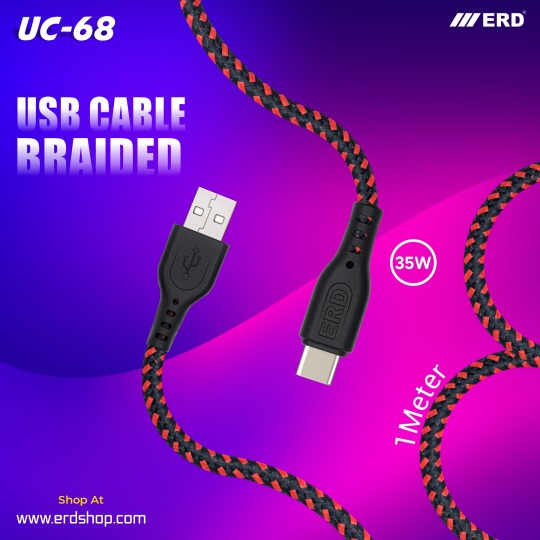
#mobilecharger#travelcharger#usbcable#microusbcable#typec#lightningcable#otgcable#hdmicable#cat6cable#extensionboard#mobilebattery#battery#charger#powerbanks#wirelessearbuds#earbuds#neckband#wirelessearphones#earphones#bluetoothspeaker#auxcable#powerbank#madeinindia#makeinindia#proudlyindian#erd
0 notes
Text
#etekcables#ethernetcables#usa#cat6cable#cat6plenum#voip phone#voipservices#telecomunicaciones#teledata
0 notes
Text
Review twisted pair HDMI extender Lenkeng LKV372AE
Main Features
The Lenkeng LKV372AE extender is considered basic in Lenkeng's lineup. It transmits video with a maximum resolution of 1080p at 60 Hz for a distance of up to 230 feet over a CAT6 cable. It should be noted that the cable category is based on the requirement for a 23 AWG wire cross-section. Theoretically, you can use CAT5e cable (24 AWG) and the range should be at least 130 feet. Going forward, during the tests we got more encouraging results for the range on CAT5e cable.
External view
The kit comes in a gray box without any advertising pictures. This usually suggests more professional applications, where "wrapping doesn't matter".
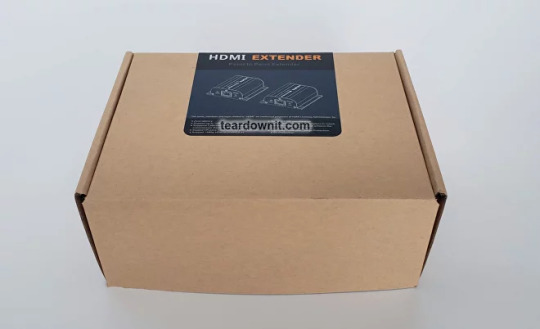
If you open the box, you can immediately see the transmitter, the receiver, and the instructions. Additional accessories (power supplies, IR transmitter, and IR receiver) are located under the soft padding.

The receiver and transmitter have a very compact design. What catches your eye are the lugs on the housing for easy mounting to surfaces. They will come in handy if you need to screw it to a wall or under a table. The transmitter and receiver housings are made entirely of high-quality metal. Except for the plastic overlay with HDMI Extender labeling, which displays the maximum range (70 meters is 230 feet) for information and to identify the Transmitter or Receiver. This plate is covered with a protective film that can be removed after installation.
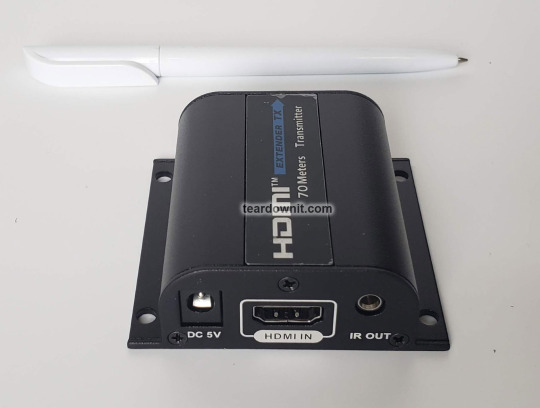

There are connectors for HDMI, power, and IR transmitter and emitter connection on the front side of the transmitter and receiver. There are also the Reset button and the LED indicator that helps to determine if there is power and if there is contact between the devices. I would like to note a good fit of the inner board with connectors to the housing. All parts fit with minimal gaps and nothing inside is loose if you shake it.
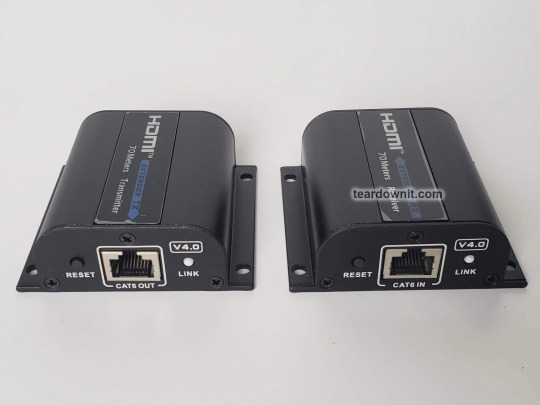
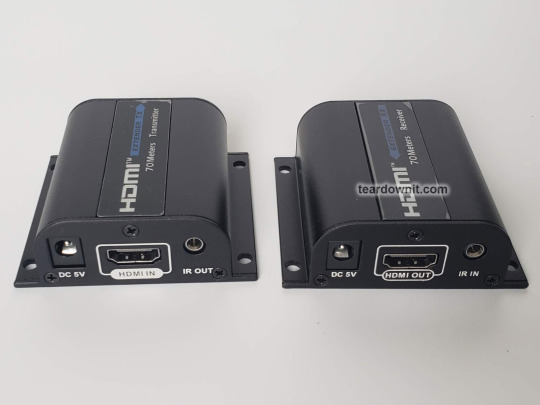
In the package, you can find an IR emitter and an IR emitter for sending the IR signal back. This additional feature is very useful for controlling an IR remote control, e.g. a TV set-top box from the TV side. The Transmitter and Emitter come with double-sided adhesive tape for attaching to surfaces. It is very odd that it is supplied separately and not glued immediately
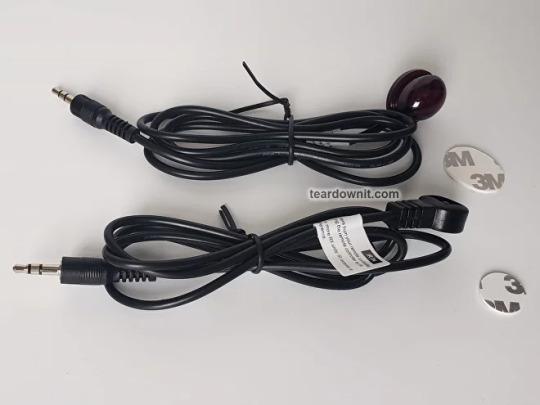
Right away we want to note the thickness of the metal from which the housing is made. It is thick enough. Perhaps this is because the smaller the housing, the better heat dissipation is needed. Anyway, we can see that the manufacturer did not try to save money here.

The board is inserted in special slots that secure it. And the edges of the board are insulated with special tape. In our opinion, the soldering is of high quality. The only disappointing thing is a little bit crooked gluing the cooling radiator to the chip. But it shouldn't affect the performance.


Performance testing
We prepared a small test bench which consisted of a laptop, a monitor, and a set of HDMI cables, CAT6 and CAT5e of several lengths. We would like to point out that for testing we used 6-ft HDMI cables, which is the standard for cables that come with many devices (monitors, TVs, set-top boxes). Initially, we tested the operation in standard mode - video transmission with 1080p 60Hz resolution using a CAT6 cable 230 feet long. We had no complaints at all. The video was transmitted on the laptop monitor and the external monitor through the transmitter and receiver set without distortion and visible delays.
During the next test, we replaced the CAT6 cable with a CAT5e, which has a smaller cross-section (CAT6 is AWG23, CAT5e is AWG24). Although the difference in the diameter of these cables is 20%, the vendor claimed that the kit should transmit video to a distance of up to 130 feet when using CAT5e cable. Maybe he decided to play it safe. We started our tests with 190 feet.
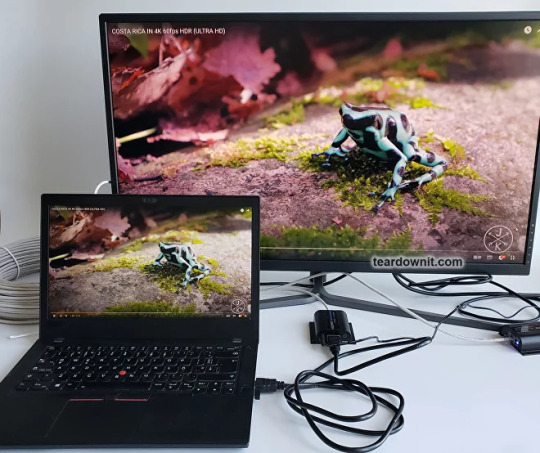
The test result surprised us because everything worked flawlessly. We can assume that it's all about the claimed performance characteristics:
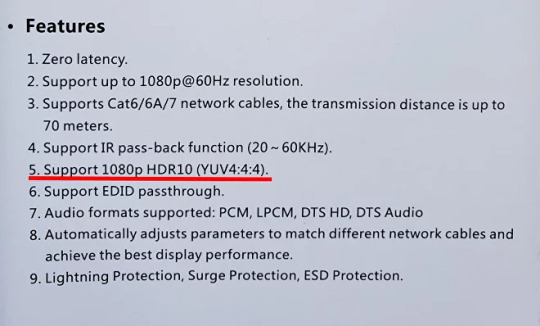
In addition to the basic 1080p60Hz video specification, the manufacturer has said that 4:4:4 color can be transmitted as well as HDR10. These two video specifications require a lot more bandwidth. In reality, most users use video with 4:2:0 color sampling and without HDR10. Only a small fraction of users will require 4:2:2 and possibly HDR. So if you already have a CAT5e cable and are unable or do not want to change it to CAT6, then first it answers a few questions: 1. What length is needed? In practice, such devices are often used to extend the signal by 100-130 feet. 2. What type of video will you be transmitting? If you are going to transmit video from a laptop, CCTV, or TV set-top box, then most likely you will not need high color and HDR 3. What kind of application are you going to use the extender in? 4:2:2 color and HDR are typically used in home entertainment applications (movies, video clips, and games). And it is more applicable to 4K equipment. It is less applicable for 1080p.
Conclusion
In conclusion, we can say that the tested set pleased us with its good appearance, quality of assembly, and fit of parts. With some small imperfections, which do not affect the operation. We had no complaints In terms of performance, and we were even pleasantly surprised by the results. It all depends on the area of its application. We recommend buying the kit for those who need a high-quality inexpensive 1080p HDMI extender over twisted pair up to 230 feet.
#LenkengLKV372AEReview#HDMIExtender#CAT6Cable#CAT5eCable#1080p60Hz#ProfessionalDevice#CompactDesign#MetalHousing#EasyMounting#IRTransmitter#IRReceiver
0 notes
Video
youtube
Difference Between CAT-6 UTP and STP Cable. #CAT6Cable #UTPCAble #SFTPCA...
1 note
·
View note
Text
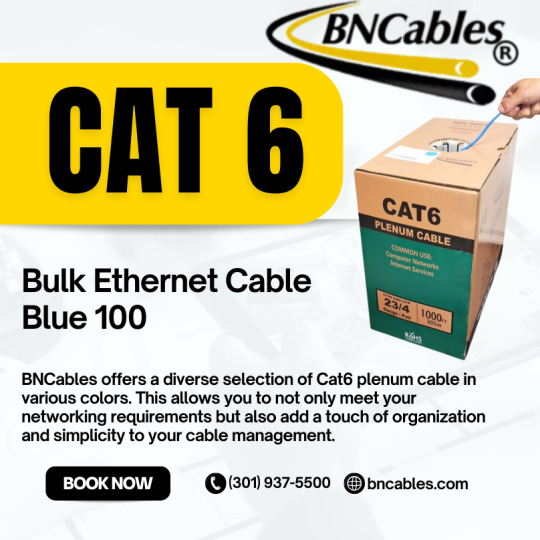
Cat6 Bulk Ethernet Cable Blue 100
BNCables offers a diverse selection of Cat6 plenum cable in various colors. This allows you to not only meet your networking requirements but also add a touch of organization and simplicity to your cable management.
Read More: https://bncables.com/product/cat6-bulk-ethernet-cable-blue-100/
cat6cables #bulkethernetcable #cat6bluecable
0 notes
Text
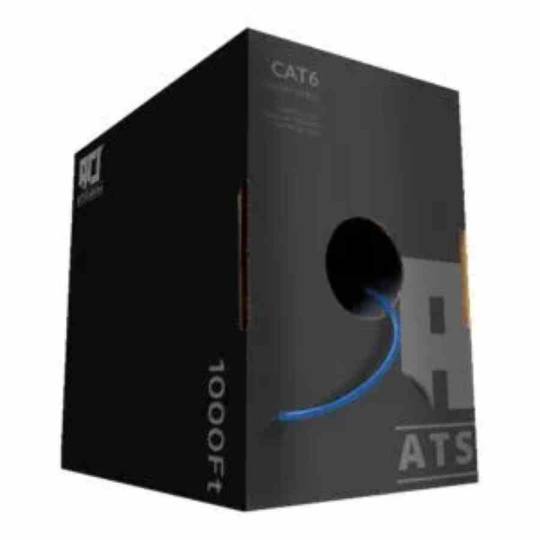
Quality Cat6 Plenum Unshielded UTP Cables for Networking
Cat6 Plenum Unshielded UTP cables deliver maximum performance. These cables are expertly designed for plenum networking. Improve connectivity with fast, durable transmission. For an exceptional network, trust our Cat6 cables.
Read More: https://atscables.com/cat6-bulk-cables/cat6-plenum-unshielded-utp/
cat6Plenum #UnshildedUTPCables #Cat6Cables
0 notes
Link
CAT6 and CAT6a are the two types of Ethernet networking cables which are superior from the prior categories in the sense of the specifications but the price do defer in the same spectrum; but are they made of pure copper?
#Wire#Wires#Cable#Cables#Ethernet#Riser#Plenum#Cat6#Cat6a#PureCopper#Copper#Cat6Plenum#Cat6aPlenum#Cat6Riser#Cat6Cables#Cat6aCables#PlenumCable#ULCable#NetworkCable
2 notes
·
View notes
Photo

Happy New Year! Discount Offer
Please Vist Our Website https://www.etekcables.com/
0 notes
Text
Get The Cat6 Right Angle Coupler For STP Networking Cables | RontechUSA
Cat6 Right Angle Coupler Jack Latch allows you to connect networking cables together and is mostly used in tight spaces around. Buy Cat6 Right Angle Coupler, DVI Cables, XLR Cables, Fiber Optic cables, HDMI cables, USB Cables, Cat8 Shielded Cables, 3.5mm cables online from RontechUSA.com
Buy It From: https://www.rontechusa.com/network-accessories/cat-5e-6-inline-couplers-1/

#3.5mmCables#HDMICables#RubberRejuvenation#USBCables#Cat6Cables#DVICables#FiberOpticCables#DisplayPortCables#SinglePortAdapterwithswitch#Cat6RightAngleCoupler#XLRCables
0 notes
Link
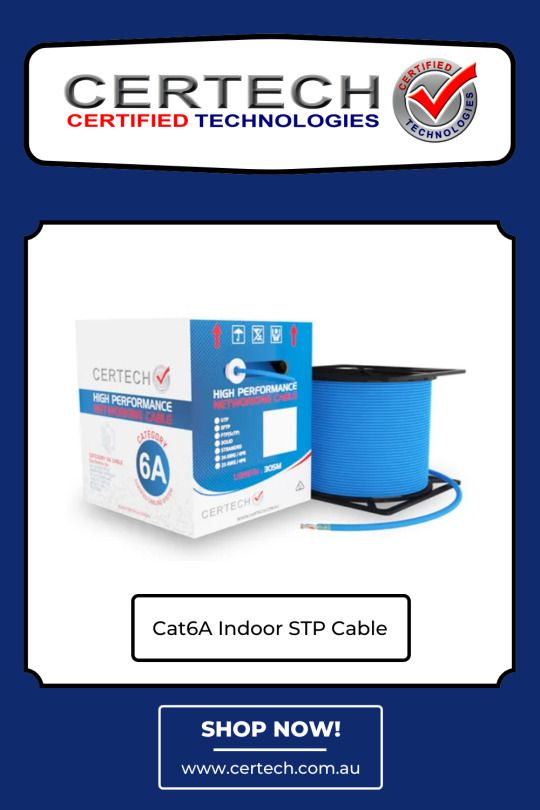
0 notes
Photo

LED SENDER BOX!
A sender box is required to send the signal from the computer to the LED displays with the help of CAT 5 or CAT 6 cable. We can control the LED screen from laptop via sender box and minimize the size of control computer.
Visit.. https://www.jonaled.com/led-sender-box
#LEDSENDERBOX#LEDBOX#senderbox#signalsenderbox#computersignal#LEDdisplays#CAT5cable#CAT6cable#LEDscreen#LEDscreencontroller#controlcomputer#LEDAccessories#LEDSpareParts#Delhi#India#LedVideoSenderBox#NovastarBox#LEDSendingBox
0 notes
Text
Safe and Fast charge with precision! ERD Technologies
💎 𝐔𝐏 𝐓𝐎 𝟐𝟓% 𝐎𝐅𝐅 + 𝐅𝐑𝐄𝐄 𝐒𝐇𝐈𝐏𝐏𝐈𝐍𝐆 ✅ 𝐎𝐫𝐝𝐞𝐫 𝐨𝐧 www.erdshop.com
Fast charge with precision! ERD Technologies brings you a USB micro cable supporting 20W VOOC protocol for swift and efficient charging.
👉 Shop Our High-Quality Wall Chargers, Car Chargers, Power Banks, Specialized Cables, OTG Cables, USB Cables, Micro USB Cables, USB-C Cables, Lightning Cables, HDMI Cables, CAT6 Cables, Extension Boards, Mobile Batteries, Wireless Earbuds, Wireless Earphones, Neckbands, Bluetooth Speakers, AUX Cables and more. 📲 If you need help in finding the right product then message us. 🌟 Made in India by ERD!

#mobilecharger#travelcharger#usbcable#microusbcable#typec#lightningcable#otgcable#hdmicable#cat6cable#extensionboard#mobilebattery#battery#charger#powerbanks#wirelessearbuds#earbuds#neckband#wirelessearphones#earphones#bluetoothspeaker#auxcable#powerbank#madeinindia#makeinindia#proudlyindian#erd
0 notes
Text
#ethernetcables#usa#cat6cable#cat6plenum#telecommunications#telecomunicaciones#voipservices#voip phone#etekcables
0 notes
Text
How to Read Ethernet Cable Jackets
Ethernet cables are engineering marvels in and of themselves, with their minuscule conductors transmitting data at breakneck speeds to provide ultimate connectivity. While the buyer's attention has remained focused on the electrical properties of bulk Ethernet cables, one critical component frequently goes unnoticed: cable jackets.
When you go to the market to buy ethernet cables, you must be familiar with all of the acronyms and terms found on the ethernet cable's jacket. It will assist you in making an informed decision and ensure that you receive the best value for your money. There is no need to be concerned if you are unfamiliar with these acronyms. You've just arrived at the correct location. All you have to do is stick around until the end!
These details, which are printed on the jackets of high-quality ethernet cable, inform us about everything we need to know about cables. These acronyms indicate whether the cable is shielded or unshielded, whether it is made of pure copper or copper-clad aluminum, and whether it is suitable for plenum spaces or outdoor installations, among other characteristics.
Therefore, without further ado, let us get straight to the point and decode this perplexing terminology.
CM CM provides specific information about the jacket rating of a high-quality ethernet cable. For example, if CMP is imprinted on the jacket, it indicates that the cable's jacket is plenum-rated, meaning that the ethernet cable is suitable for use in plenum spaces. Similarly, if CMR is imprinted on the cable, it indicates that the jacket is riser-rated, and the cable is ideal for use in riser spaces.
AWG 24 (American Wire Gauge)
The abbreviation AWG stands for American Wire Gauge. It is a standard unit of diameter measurement for electrical conductors. It enables customers to determine the capacity of electrical conductors to carry current. The name implies that this unit of measure is used in North America.
Cat6 cables are 22AWG to 26AWG in diameter.
UL is an acronym for Underwriter's Laboratories (UL)
UL is a non-profit organization that regulates the design and manufacture of Ethernet cables. While UL certification is not a mandatory requirement under federal law, some businesses require insurance purposes.
UTP
This abbreviation refers to an unshielded twisted pair. It indicates that while a high-quality Ethernet cable is shielded against crosstalk and EMI, the inner four twisted pairs are unshielded or lack an additional layer of protection.
STP
STP is an acronym for shielded twisted pair. When STP is imprinted on bulk ethernet cables, it adds a layer of protection against crosstalk, EMI, and noise. This additional protection is provided by screening or shielding material wrapped around each twisted pair; the shielding material may be a copper braid or foil wrapping.
PVC
PVC stands for polyvinyl chloride. It is frequently used as the jacket material for bulk ethernet cables designed for outdoor use. It is relatively inexpensive, so PVC cables are significantly less expensive than riser-rated or plenum-rated Ethernet cables.
CPVC
CPVC refers to chlorinated polyvinyl chloride on the jacket of the cable. If a cable's jacket is imprinted with CPVC, it has a much higher temperature resistance. Cables labeled with CPVC are fire retardant and will halt the spread of a fire if one occurs.
Low Smoke Zero Halogen (LSZH) LSZH stands for Low Smoke Zero Halogen. In the event of a fire, this material will burn with little smoke and emit no halogen.
FEB
Fluorinated Ethylene Polymer is a type of plastic that is used to make plenum-rated Ethernet cables. Additionally, it is used in PVC cables that emit little smoke when exposed to fire.
568 TIA/EIA
It demonstrates that the Ethernet cables in bulk conform to the Telecommunications Industry Association's industry standards. This standard establishes requirements for the installation and planning of structured cabling systems in commercial buildings.
XLPE
It is an acronym for polyethylene that has been cross-linked. It is a suitable substitute for PVC and is ideal for applications involving high temperatures.
This imprinting indicates that if you expose your ethernet cable to temperatures above that threshold for an extended period, it will begin to degrade.
If printed, it indicates that the testing laboratories have verified the bulk ethernet cables.
A Cat (5,6,7)
The Cat denotes the category, while the number indicates the generation; the higher the number, the more recent the age.
We hope this article has answered all of your questions about how to read the ethernet cable jacket. After reading this article, we are reasonably confident that you will make an informed decision when it comes time to purchase Ethernet cables.
0 notes